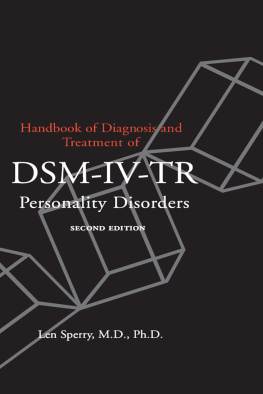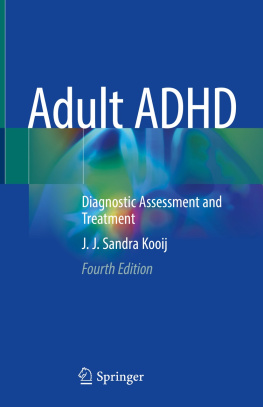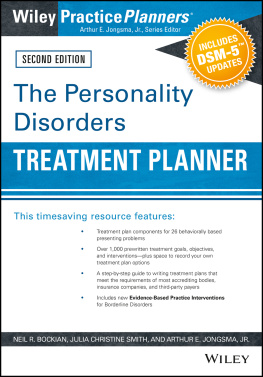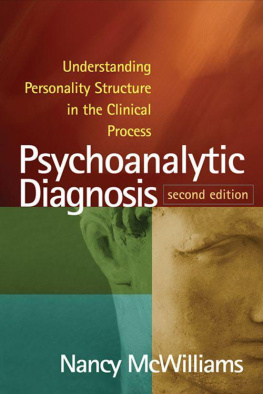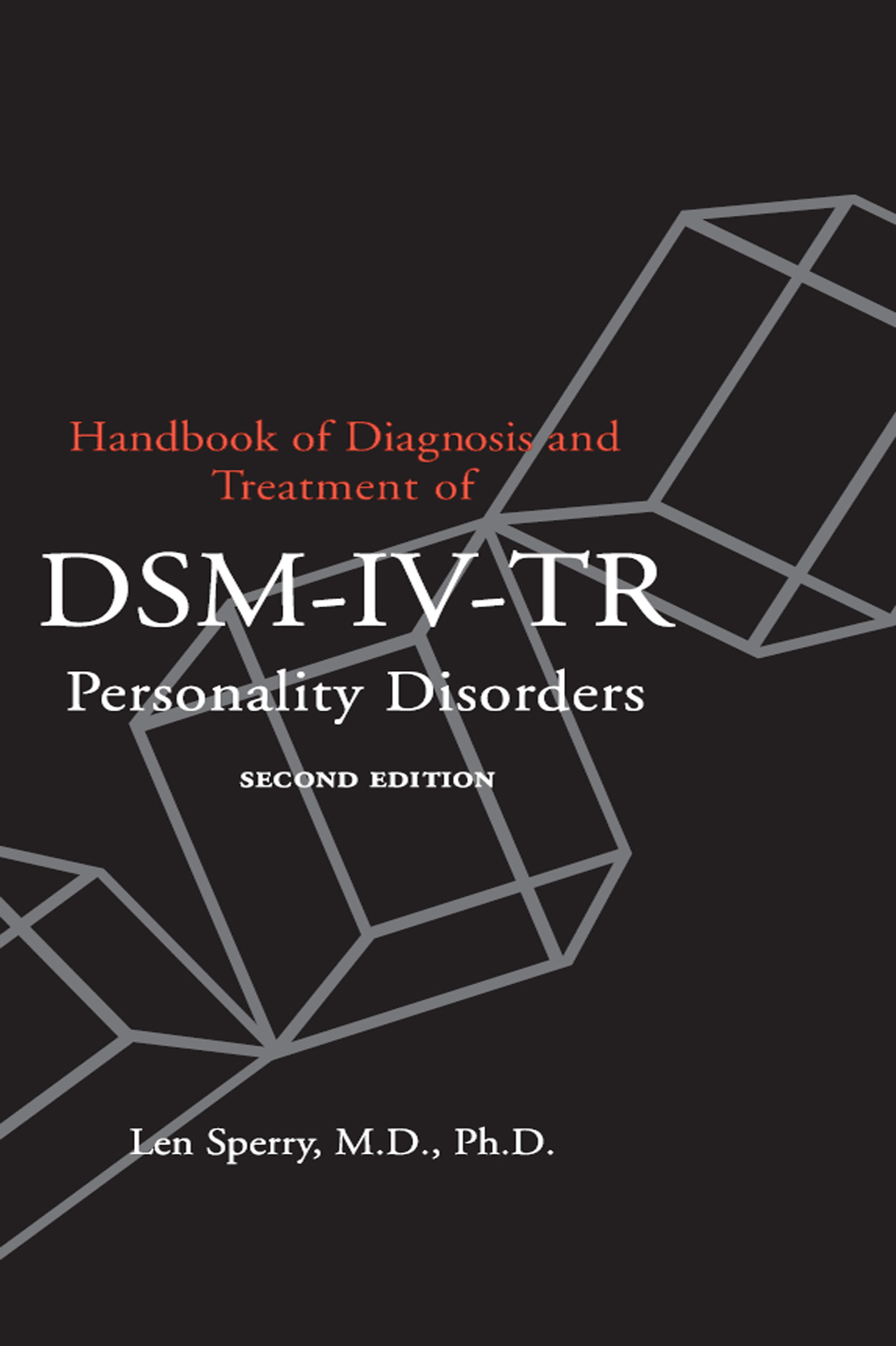Len Sperry, M.D., Ph.D.
Brunner-Routledge is an imprint of the Taylor & Francis Group.
This edition published in the Taylor & Francis e-Library, 2005.
To purchase your own copy of this or any of Taylor & Francis or Routledge's collection of thousands of eBooks please go to www.eBookstore.tandf.co.uk.
All rights reserved. No part of this book may be reprinted or reproduced or utilized in any form or by any electronic, mechanical, or other means, now known or hereafter invented, including photocopying and recording, or in any information storage or retrieval system, without permission in writing from the publishers.
Foreword
This book is to be read by both clinical professionals and graduate students alike. It is a thoughtful and practical reference text that readers will find useful time and time again as they face the difficult-to-treat patients who meet the criteria for personality disorders. Until two decades ago, the position of these disorders occupied a peripheral, if not a strained place in clinical psychology and psychiatry. The turn of events has been almost startling, with the DSM-III and IV giving these disorders a major position, via Axis II, in their innovative multiaxial model.
Trained as both a psychologist and a psychiatrist, Dr. Sperry is well prepared to be a discerning and organized teacher of clinical diagnosis and treatment. A sound and effective communicator, he presents complex ideas in a clear, and easily understandable, fashiona talent not especially common among authors in this increasingly central clinical field. His exposition and synthesis is most impressive.
Especially important, Sperry recognizes the significant advances that have taken place in the field of personality disorders in the past decade, hence justifying the updating of his well-received and widely read first edition. Moreover, the increasing need for mental health services has mounted astronomically, as people have become aware that their psychological needs can raise havoc on their health, career, social relationships, personal well-being, and creativity. No longer willing to accept their discontents and the unhappiness that has visited them by unkind circumstances, more people than ever are looking for competent professional help. What has also become strikingly clear is that most patients who seek assistance are suffering from the difficulties of longstanding maladaptive attitudes and coping styles, essentially what have come to be labeled personality disorders. What is needed are efficient diagnostic tools that enable clinicians to quickly recognize problematic character structures and a number of implementable, pragmatic, and short-term modes for treatment. It is in achieving these goals that Dr. Sperry's text will prove most useful.
His approach goes beyond merely describing the simple content of personality disorders. Dr. Sperry helps provide the reader with anunderstanding of the underlying sources and treatment implications of these disorders. The book will certainly assist those with considerable clinical experience, but it will be especially appreciated by beginners who will soon be introduced to clinical work with these problematic patients. This text assists the novice clinician every step along the way, from initial diagnostic contact to final treatment evaluation.
As Sperry points out, the realm of personality disorders has become increasingly significant in psychotherapeutic practice; it now fills a space that formerly focused solely on schizophrenia and affective psychosis. Whereas these latter illnesses are present in only a small proportion of patients seen by clinicians today, the dysfunctions of personality have become omnipresent, whether one practices marital and family therapy, forensics, behavioral medicine and health psychology, neuropsychology, or any of the other main realms of outpatient work. Not unexpectedly, the literature in this field has grown immensely and shortly will outstrip all other areas of psychological and psychiatric practice in the coming decade. If my own broad-ranging text Disorders of Personality has seen some 30 printings in its two editions thus far, then Dr. Sperry's current volume will add further to the impressive growth and acceptance of useful books in the field.
Sperry's text adds meritoriously to the mental health field's decision to assign a key position to this highly prevalent realm of psychotherapeutic practice. It is a noteworthy commendation of this work that his publishers encouraged him to write a revision, a thorough and updated text in a flourishing field of study.
-Theodore Millon, Ph.D., D.Sc.
Dean and Scientific Director,
Institute for Advanced Studies in Personology and Psychology
Preface
When the Handbook of Diagnosis and Treatment of DSM-IV Personality Disorders was released in 1995, it was the first personality disorders book based on DSM-IV to appear after the publication of DSM-IV. The Handbook was unique in many respects. It was a reader-friendly, single-authored text that offered a comprehensive and integrative approach to the diagnosis and treatment of personality disorders. Rather than focusing on a single treatment approach or modality, it basically covered all the approaches and modalities: individual therapies, group therapy, marital and family therapy, medication management, as well as combined and integrative approaches.
Since the Handbook's publication, a number of exciting and significant developments involving personality disorders have emerged. Most notable has been the increasing number of clinicians who are utilizing effective and successful treatments for what were previously considered untreatable disorders. The paradigm shift in clinicians attitudes about the treatability of personality disorders was convincingly evident by the late 1990s. This attitude change, reflected in the actual treatment experience of many clinicians, involved a shift from a sense of dread and hopelessness to one of hope and optimism that even the most difficult of these disordersincluding borderline personality disorderare becoming increasingly treatable with the newer, focused treatment strategies and interventions.
In 2000, the American Psychiatric Association published the Diagnostic and Statistical Manual of Mental Disorders, Fourth Edition Text Revision (DSM-IV-TR). As the title suggests, the text and background information supporting the DSM diagnostic categories were primarily revised, rather than specific diagnostic criteria. The main justification for this new DSM was that significant advances in both research and clinical practice had occurred since 1994 the year DSM-IV was publishedand this warranted updating the text.

